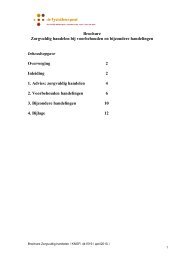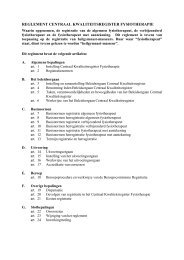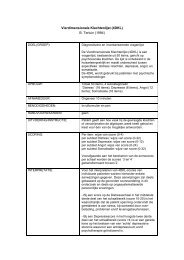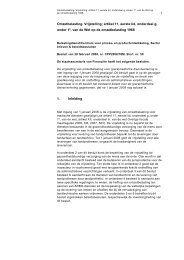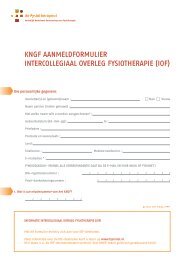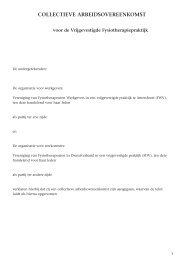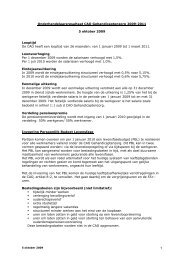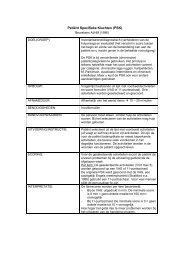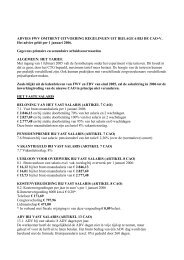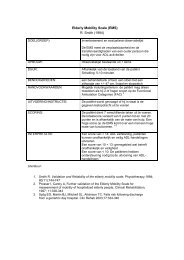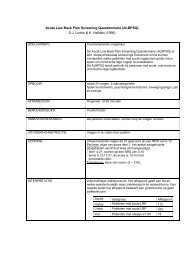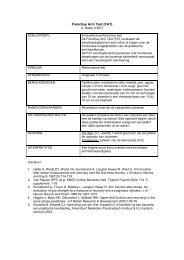Acupuncture and dry-needling for low back pain (Review)
Acupuncture and dry-needling for low back pain (Review)
Acupuncture and dry-needling for low back pain (Review)
Create successful ePaper yourself
Turn your PDF publications into a flip-book with our unique Google optimized e-Paper software.
Ding 1998<br />
Methods<br />
Participants<br />
Interventions<br />
Outcomes<br />
Notes<br />
- R<strong>and</strong>omized (method not described). No mention of concealment of allocation.<br />
-Patients blinded<br />
-Funding: not reported<br />
-Setting: University in GuangZhou, China<br />
-In<strong>for</strong>med consent: Not reported<br />
-Ethics approval: Not reported<br />
-All patients were fol<strong>low</strong>ed<br />
-Analysis: chi-squares between groups<br />
54 patients with chronic <strong>low</strong>-<strong>back</strong> <strong>pain</strong>, frequent recurrence, worse during work <strong>and</strong> relief with rest<br />
Diagnosis: chronic <strong>low</strong>-<strong>back</strong> <strong>pain</strong>.<br />
Excluded: specific pathological entities using lab tests <strong>and</strong> x-rays<br />
Mean age: 45 years old in the ancient <strong>needling</strong> technique <strong>and</strong> 42 in regular <strong>needling</strong> technique group (range 19-68)<br />
40 males <strong>and</strong> 14 females<br />
Working status: ?<br />
Previous treatments: ?<br />
1) Ancient <strong>needling</strong> technique “The turtle exploring the holes”. Major points: GV3, Ashi point(s). Supplement<br />
points: BL40. Needles 0.38 mm X 75 mm were used <strong>for</strong> deeper insertion <strong>and</strong> to different direction in 45 degree<br />
angle. Strong Teh chi sensation was obtained. The needles were retained <strong>for</strong> 40 to 50 minutes. Treatments were given<br />
daily up to 10 treatments.<br />
R<strong>and</strong>omized to this group: 35<br />
2) Regular <strong>needling</strong> technique. Needles 0.38 mm X 75 mm were used <strong>for</strong> deeper perpendicular insertion with twirling<br />
or rotating technique was used until strong Teh Chi sensation was acquired. Needle retaining was 20 minutes with<br />
3 to 4 times twirling or rotating stimulation in between. Treatments were given daily <strong>for</strong> up to 10 days.<br />
R<strong>and</strong>omized to this group: 19<br />
1. Pain on a 4-point scale: “cure”: no <strong>pain</strong> <strong>for</strong> 2 months;<br />
“marked effective”: <strong>pain</strong> markedly improved;<br />
“improved”: <strong>pain</strong> is somewhat relieved; <strong>and</strong> “no change”.<br />
Measured immediately after <strong>and</strong> 2 months after the end of the sessions<br />
Costs: Not reported<br />
Complications: Not reported<br />
Language: Chinese<br />
Publication: full paper<br />
No additional in<strong>for</strong>mation from authors<br />
For results, see the other data table:<br />
7.3<br />
Conclusions: “An ancient <strong>needling</strong> technique is better than the regular <strong>needling</strong> technique in treating chronic <strong>low</strong><br />
<strong>back</strong> <strong>pain</strong>”<br />
<strong>Acupuncture</strong> <strong>and</strong> <strong>dry</strong>-<strong>needling</strong> <strong>for</strong> <strong>low</strong> <strong>back</strong> <strong>pain</strong> (<strong>Review</strong>)<br />
Copyright © 2011 The Cochrane Collaboration. Published by John Wiley & Sons, Ltd.<br />
27



